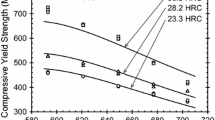Conclusions
-
1.
The service life of dies made of ESR steel is ∼30% higher than that of dies made from hot-rolled steel.
-
2.
The ESR steel is characterized by high isotropicity and a smaller quantity of nonmetallic inclusions in comparison with the hot-worked steel.
-
3.
As the result of losses during electroslag remelting, the quantity of silicon, molybdenum, and chromium decreases ∼10%, and the quantity of sulfur and phosphorus to approximately one-half.
Similar content being viewed by others
Literature cited
B. E. Paton and B. I. Medovar (editors), Electroslag Furnaces [in Russian], Naukova Dumka, Kiev (1976).
Additional information
Moscow Automobile Factory. Translated from Metallovedenie i Termicheskaya Obrabotka Metallov, No. 9, pp. 45–47, September, 1980.
Rights and permissions
About this article
Cite this article
Sedunov, V.K., Kokin, S.D. & Il'ina, L.F. Structure and properties of dies made from steels prepared by electroslag remelting. Met Sci Heat Treat 22, 680–682 (1980). https://doi.org/10.1007/BF00700698
Issue Date:
DOI: https://doi.org/10.1007/BF00700698




